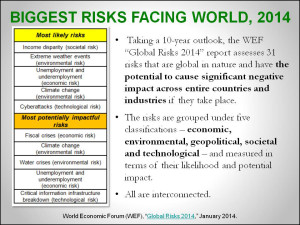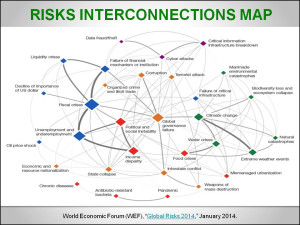3 Reasons I Love the WEF “Global Risks 2014” Report

In my last blog, I declared that it was time for sustainability champions to unleash three risk arguments for more proactive action on climate change. Last week, I discovered a goldmine of support for the company-level and society-level risk arguments in the debate about climate destabilization: a new report from the World Economic Forum (WEF), “Global Risks 2014.” There are three reasons that I am excited about this report.
1. It is highly credible and complete.
The World Economic Forum (WEF) does not sound like a radical, tree hugging organization. It hosts the high-profile WEF Annual Meeting in Davos, Switzerland, attracting world political and business leaders. It has street cred with the business community.
The report is based on a survey about 31 selected global risks sent to over 700 leaders and decision-makers from the World Economic Forum’s global multi-stakeholder global community. Respondents were from business (41%), academia (18%), non-governmental organizations (17%), international organizations and government. It uses a 10-year horizon, and under-30s accounted for 22% of respondents.
The survey was conducted between October and November 2013, so it is current. This is the ninth annual edition? The WEF knows how to do it with rigor, as explained in its appendix. It helpfully divides the 31 risks into five categories: economic, environmental, geopolitical, societal, and technological. The environmental and societal risks are the most relevant for sustainability champions, plus some risks in other categories might be considered as governance-related risks when we use the environmental, social, and governance (ESG) framework.
2. It ranks climate change as a very high global risk
It is significant that climate change and its close cousin, water crises, are ranked as high risks in the report’s three lists: in the Top-10 Risks of Highest Concern in 2014, water crises, failure of climate change mitigation and adaptation, and greater incidence of severe weather events are ranked 3rd, 5th, and 6th respectively; extreme weather events and climate change are ranked 2nd and 4th in the Top-5 Most Likely Global Risks; and climate change and water crises are ranked 2nd and 3rd in the Top-5 Most Impactful Global Risks.
Most impactful to whom? To business, government, and society. The risks are systemic and erode trust in institutions, especially businesses. High impact risks like climate change deserve inclusion in corporations’ enterprise risk management (ERM) processes. They are relevant and legitimate.
It is significant that climate change and its close cousin, water crises, are ranked as high risks in the report’s three lists: in the Top-10 Risks of Highest Concern in 2014, water crises, failure of climate change mitigation and adaptation, and greater incidence of severe weather events are ranked 3rd, 5th, and 6th respectively; extreme weather events and climate change are ranked 2nd and 4th in the Top-5 Most Likely Global Risks; and climate change and water crises are ranked 2nd and 3rd in the Top-5 Most Impactful Global Risks.
3. It connects the dots
A helpful map on page 21 of the report shows the network of connections among the 31 risks. The four central hubs in the web are fiscal crises, global governance failure, climate change, and political and social instability. As we would expect, climate change is closely connected to extreme weather events, water crises, biodiversity loss, man-made environmental catastrophes, and natural catastrophes.
As a father and grandfather, I am not happy that we are facing these global risks. However, as a change agent and sustainability champion, I am happy that this report from a respected institution can be referenced when we seek company-level and society-level action to avoid climate destabilization.
The WEF confirms that climate change is a priority issue that screams for immediate attention. Climate change is the mother of several high-impact sustainability-related risks to business success. Action is not optional; it is urgent and necessary.
Case closed.
(Note that the above slides will be included in my March update to subscribers to my master Sustainability Advantage Slide set).
Please feel free to add your comments and questions using the Comment link below. For email subscribers, please click here to visit my site and provide feedback.
Bob






Comments are closed.